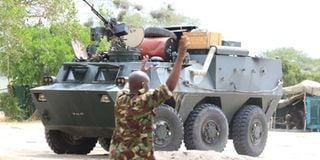Kenya needs Somalia in war on terror

A Kenyan soldier who is part of the African Union Mission in Somalia is pictured at a base on February 11, 2017.
What you need to know:
- Terrorist attacks from Al-Shabaab on Kenya their control of Jubbaland and Kismayu, prompted Nairobi’s military incursion into Somalia in 2011.
Kenya has enjoyed a long history of cooperation and peace with Somalia. However, historical differences have intermittently undermined Kenya-Somalia relations since early 1960s leading to war in 1964.
Later, Kenya adopted a dual-track policy based on a mutual defence pact between Kenya and Ethiopia in 1964 on one hand, and more cooperative relations with Somalia on the other hand until 1991. The fall of Somalia’s last military government of General Siad Barre in 1991 and subsequent civil war, challenged Kenya’s foreign policy.
There was no space for continuity amid civil war and fragmentation of national sovereignty to clan “war-lordship”. The resulting instability and civil war drove hundreds of thousands of Somali refugees into Kenya, led to state collapse, and encouraged militant and extremist groups in Somalia, which later gave birth to Al-Shabaab. The extremist group is arguably Kenya’s enemy number one today.
Since early 2000s, while Somalia struggled in the throes of protracted civil war, clan “warlordism” and extremist militancy, Kenya invested itself in the peace process, stabilisation and reconstruction of Somalia. While the immediate goal was to stabilise the nation for greater security and peace in the region, a stable Somalia would guarantee Kenya’s national security and economic interests and facilitate repatriation of refugees.
Foreign powers
However, Kenya’s “peace building” policy, dualised with cooperation with nascent post-civil war governments of Somalia, was disrupted by the capture of Mogadishu, southern and central Somalia, by the Islamic Courts Union (ICU) and later Al-Shabaab. The entry of other regional and foreign powers in Somalia complicated Kenya’s policy. Al-Shabaab mounted a pan-Somali Islamist campaign at home and against regional countries.
Terrorist attacks from Al-Shabaab on Kenya (a threat to tourism industry and Lapsset), their control of Jubbaland and Kismayu (port city and commercial hub), prompted Nairobi’s military incursion into Somalia in 2011.
Kenya later enlisted its forces into Amisom in 2012, thereby militarising its policy towards Somalia. Secondly, a mix of foreign influence and ex-Al-Shabaab political class in Mogadishu drove another wedge in Kenya - Somalia relations through a maritime boundary dispute in the Indian Ocean, which boiled from 2009 and landed at the International Court of Justice in 2014. The maritime dispute threatens Kenya’s territorial integrity.
In 2012, Kenya Defence Forces deployed in Jubbaland by Amisom and working with Ras Kamboni militia, drove Al-Shabaab from Kismayu and other key towns in Jubbaland. The Ras Kamboni Movement’s leader, Sheikh Ahmed “Madobe” Islam, was then elected to Jubbaland’s regional presidency in 2013, and maintained his close working relationship with KDF in Jubbaland to stamp out Al-Shabaab.
With Al-Shabaab influence and presence diminishing in the subsequent years, Jubbaland became a natural buffer zone for Kenya against Al-Shabaab, and now serves as a gateway to Somali markets, especially Kismayu.
Stability for Jubbaland implies that Kenya may begin to repatriate refugees. However, the maritime problem naturally gives Jubbaland geo-strategic prominence.
Pamba Al Pamba, Nairobi




